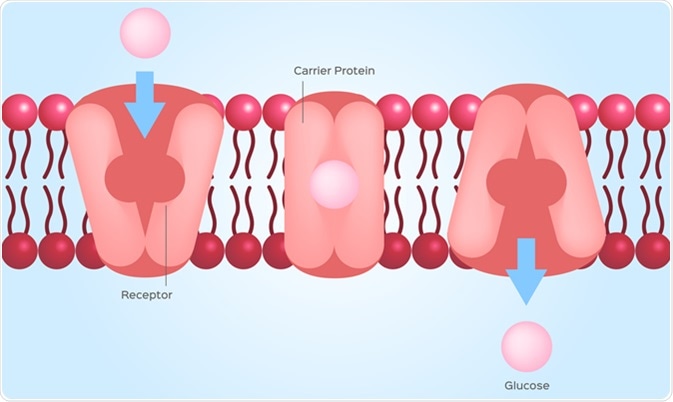Cells continuously move materials in and out through their cell walls. Facilitated transport is one way of moving those materials without expending cellular energy. In facilitated transport, materials are moving down a concentration gradient. In other words, they are moving from an area of high concentration to low concentration, as in passive diffusion. However, the presence of the cell membrane prevents passive diffusion from moving the materials easily, because a protein-free lipid bilayer is highly impermeable to ions. Small nonpolar molecules like O2 and CO2 are soluble in lipids and diffuse rapidly across lipid bilayer membranes.

Facilitated diffusion or facilitated transport / cell anatomy. Image Credit: Gritsalak Karalak / Shutterstock
Uncharged polar molecules like water and urea also diffuse across the bilayer, but at a slower rate. Charged molecules, however, do not readily diffuse across a lipid bilayer membrane and they require additional assistance.
In facilitated transport, membrane proteins assist the diffusion of materials through the cell membrane. The protein binds the molecule being transported on the surface of the membrane, then passes it to interior proteins that typically form a channel or pore in the membrane. These proteins are called transport proteins.
Carrier Proteins
One type of transport protein is known as a carrier protein. When the target molecule to be transported binds to it, it undergoes a conformational change which moves the molecule from one side of the membrane to the other. There is usually only one target protein per carrier protein, and there are a limited number of them on the cell membrane. The limitations on these proteins can, at times, limit the availability of material in the cell.
The glucose transporter 1 (GLUT1) protein is an example of a carrier protein for facilitated transport of glucose into cells. Glucose is required for production of energy in cells. A supply of glucose is provided through the blood plasma. GLUT1 has 12 hydrophobic helical segments arranged around a central channel through which glucose passes. The rate of facilitated diffusion of glucose into the cell is about 50,000 times greater than uncatalyzed diffusion through the membrane. GLUT1 permits the necessary low level of glucose uptake to sustain respiration in cells.
Channels
The other category of transport protein is the channel. A channel protein has a hydrophilic portion on the inside and outside of the membrane, and a hydrophobic potion that penetrates the membrane that forms a channel. The inside of the channel is hydrophilic, so that polar molecules can diffuse through it.
Aquaporins are one type of channel protein that transport water or small solutes. They are highly conserved in bacteria, plants, and animals. More than 10 isoforms of aquaporin have been identified in mammalian cells. These proteins are expressed differently in different types of cells and tissues, indicating that each has a specific role in its organ.
The acetylcholine receptor is another type of channel protein. It mediates transmission of nerve signals across synapses, or junctions between neurons. The receptor opens in response to the binding of acetylcholine. A channel protein that opens upon binding of a ligand is called a ligand-gated channel.
References
- Passive transport: facilitated transport, https://openoregon.pressbooks.pub/mhccmajorsbio/chapter/passive-transport-facilitated-transport/
- Molecular Biology of the Cell. 4th edition., https://www.ncbi.nlm.nih.gov/books/NBK26815/
- Aquaporins: water channel proteins of the cell membrane, https://www.ncbi.nlm.nih.gov/pubmed/15242101
Further Reading